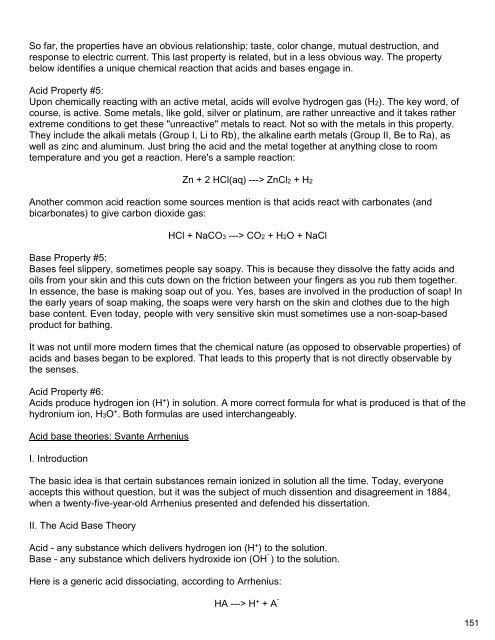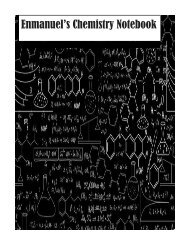You also want an ePaper? Increase the reach of your titles
YUMPU automatically turns print PDFs into web optimized ePapers that Google loves.
So far, the properties have an obvious relationship: taste, color change, mutual destruction, and<br />
response to electric current. This last property is related, but in a less obvious way. The property<br />
below identifies a unique chemical reaction that acids and bases engage in.<br />
Acid Property #5:<br />
Upon chemically reacting with an active metal, acids will evolve hydrogen gas (H2). The key word, of<br />
course, is active. Some metals, like gold, silver or platinum, are rather unreactive and it takes rather<br />
extreme conditions to get these "unreactive" metals to react. Not so with the metals in this property.<br />
They include the alkali metals (Group I, Li to Rb), the alkaline earth metals (Group II, Be to Ra), as<br />
well as zinc and aluminum. Just bring the acid and the metal together at anything close to room<br />
temperature and you get a reaction. Here's a sample reaction:<br />
Zn + 2 HCl(aq) ---> ZnCl2 + H2<br />
Another common acid reaction some sources mention is that acids react with carbonates (and<br />
bicarbonates) to give carbon dioxide gas:<br />
HCl + NaCO3 ---> CO2 + H2O + NaCl<br />
Base Property #5:<br />
Bases feel slippery, sometimes people say soapy. This is because they dissolve the fatty acids and<br />
oils from your skin and this cuts down on the friction between your fingers as you rub them together.<br />
In essence, the base is making soap out of you. Yes, bases are involved in the production of soap! In<br />
the early years of soap making, the soaps were very harsh on the skin and clothes due to the high<br />
base content. Even today, people with very sensitive skin must sometimes use a non-soap-based<br />
product for bathing.<br />
It was not until more modern times that the chemical nature (as opposed to observable properties) of<br />
acids and bases began to be explored. That leads to this property that is not directly observable by<br />
the senses.<br />
Acid Property #6:<br />
Acids produce hydrogen ion (H + ) in solution. A more correct formula for what is produced is that of the<br />
hydronium ion, H3O + . Both formulas are used interchangeably.<br />
Acid base theories: Svante Arrhenius<br />
I. Introduction<br />
The basic idea is that certain substances remain ionized in solution all the time. Today, everyone<br />
accepts this without question, but it was the subject of much dissention and disagreement in 1884,<br />
when a twenty-five-year-old Arrhenius presented and defended his dissertation.<br />
II. The Acid Base Theory<br />
Acid - any substance which delivers hydrogen ion (H + ) to the solution.<br />
Base - any substance which delivers hydroxide ion (OH¯) to the solution.<br />
Here is a generic acid dissociating, according to Arrhenius:<br />
HA ---> H + + A¯




